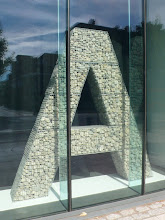A while ago, after seeing some of my letterpress prints, a friend of mine said to me that she thought I was a kind of 'urban Richard Long.' Whilst flattered to be held in comparison, or perhaps parallel, I wondered what the similarities or disimilarities might be.
In basic terms I suppose I do undertake a lot of walking, I do take photographs and I do use type—all seen in the work of Long, though his journeys are more often undertaken in the open spaces of fields and mountains, not the urban confines of Hackney.
For me, however, the walking is a prelude to the work, it is a method for exploring, experiencing and thinking about place. For Long, the walk is the art, as much as the documentation of it that appears on the gallery wall. He assigns each element equal and complementary status, seeing his art as the essence of his experience not a representation of it. Apparently he was inspired by Lawrence Weiner's work and the idea that 'a work need not be made,' that one can replace the object with language. Hmm, nice idea, maybe, I could just submit a thesis and scrap all this practice...
Seriously though, I feel there is another overlap here. What I am trying to do with my research and practice is generate a geo/graphic design process that enables the development of visual design work that offers the reader an experience of place, one that goes beyond the geometric concerns of the traditional map, or the 'skeletal landscape of statistics.' This shift from representation to experience is something the Fluxus artists explored with their Fluxkits, attempting to sidestep the problems of representation and the instability of meaning—this is not something about a thing, it is the thing itself. I guess this also links to the previous post about the use of / and the way it might change the interpretation of re/presentation as opposed to representation.
Long seems to have developed a bit of a system for his visual re/presentation. He usually documents his work/walk with an image of the location and a text work that records selected facts or experiences of the walk. The majority of these share a simplicity of form using a single typeface (predominantly Gill Sans), with words usually set in caps and either centred or range left. The type is usually printed in a combination of black with one other colour, more often than not, red, blue or green.
As a graphic designer—and one who is persistently pondering Mermoz's idea of 'working at the level of the text'— this seems a little problematic. Why Gill for starters? Was he aware of any connotations (bestiality or otherwise)? Yes I can see the logic for the English walks, it is associated with the identity of the BBC, Gill was a pupil of Johnston who designed the London Transport face, and the visual references are obvious, but what about the walks in other countries. What about the difference between a walk in a field of corn and a boulder strewn desert? The walks and the experiences on them are clearly different, so why is the type so systematic? It seems to bear no relation to the content. Maybe the 'Englishness' is about Long himself, but then the art doesn't seem about him—as much as his body is a tool in its making—it seems about the experience he has within the landscape.
Perhaps Long is attempting to find a 'neutral' form, to allow the words to express themselves somehow free of their visual form? But surely the two are inextricably linked and, as Robin Kinross noted, this is really just a 'rhetoric of neutrality', therfore it is in fact a style in itself, with its own connotations.
As an artist, I suppose Long has had to build up a body of work over a period of time that becomes something of a 'signature' that is instantly recognisable. Essentially Gill Sans is as much a part of the Richard Long brand identity as it is the BBC's. To that end the type is performing a role, but it doesn't seem to be one that is actually about each specific work or walk itself.
Tuesday, 13 April 2010
Subscribe to:
Post Comments (Atom)


No comments:
Post a Comment